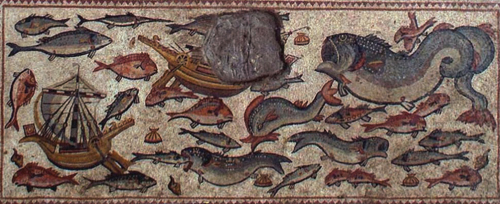 Footprints left by the artists and workers who made the largest and most beautiful Roman-era mosaic in Israel 1,700 years ago have been discovered in the plaster underneath the mosaic. Archaeologists were in the process of conserving the famous Lod Mosaic when they found the imprints of bare feet and sandals shown clearly in the plaster bed onto which the mosaic was later laid.
Footprints left by the artists and workers who made the largest and most beautiful Roman-era mosaic in Israel 1,700 years ago have been discovered in the plaster underneath the mosaic. Archaeologists were in the process of conserving the famous Lod Mosaic when they found the imprints of bare feet and sandals shown clearly in the plaster bed onto which the mosaic was later laid.
The conservation experts from the Israel Antiquities Authority were detaching each piece of the 180 square-metre mosaic before taking it to conservation laboratories in Jerusalem.
Jacques Neguer, head of the Israel Antiquities Authority’s conservation branch, said: The excitement here was great. It is fascinating to discover a 1,700 year old personal mark of people who are actually like us, who worked right here on the same mosaic. We feel the continuity of generations here.
 The footprints would have been made as the artisans prepared the plaster base for the mosaic pieces. Even the shoe sizes are known they range from size 34 to 44. With Israeli shoe sizes being the same as the European system, this would translate into UK sizes from around a 3 to a 9.5 (US around 4 to 10.5). This could suggest that some of the people working on the mosaic were children. According to Neguer, at least one of the prints is very similar to that of a modern sandal. His team has concluded that it is likely that the team of builders would have flattened the mortar down with their bare (or sandalled) feet.
The footprints would have been made as the artisans prepared the plaster base for the mosaic pieces. Even the shoe sizes are known they range from size 34 to 44. With Israeli shoe sizes being the same as the European system, this would translate into UK sizes from around a 3 to a 9.5 (US around 4 to 10.5). This could suggest that some of the people working on the mosaic were children. According to Neguer, at least one of the prints is very similar to that of a modern sandal. His team has concluded that it is likely that the team of builders would have flattened the mortar down with their bare (or sandalled) feet.
Neguer explained: When removing a section of mosaic it is customary to clean its bedding, and that way study the material from which it is made and the construction stages. We look for drawings and sketches that the artists made in the plaster and marked where each of the tesserae will be placed. This is also what happened with the Lod mosaic: beneath a piece on which vine leaves are depicted, we discovered that the mosaics builders incised lines that indicate where the tesserae should be set, and afterwards, while cleaning the layer, we found the imprints of feet and sandals.
 Neguer also pointed out that the mosaic was made in three parts, probably in different periods, and almost certainly by different artists. There are different kinds of art here, and we can see that the hand that affixed the tesserae is different: a trained eye recognizes that the preparation which was done prior to the work is different. Besides the necessary professionalism, exposing the footprints is also the result of a lot of luck. It is not always possible to cut the layers of the mosaic precisely so that we discover such a clear picture of the plaster with the incising on it.
Neguer also pointed out that the mosaic was made in three parts, probably in different periods, and almost certainly by different artists. There are different kinds of art here, and we can see that the hand that affixed the tesserae is different: a trained eye recognizes that the preparation which was done prior to the work is different. Besides the necessary professionalism, exposing the footprints is also the result of a lot of luck. It is not always possible to cut the layers of the mosaic precisely so that we discover such a clear picture of the plaster with the incising on it.
Conservation work on the mosaic began earlier this year as reported in this earlier blogpost even though the mosaic was first discovered in 1996. It took 13 years for funds to be raised to finance the conservation process. The site is in the city of Lod, near to Ben Gurion airport, east of Tel-Aviv, which was last week placed on the World Monument Fund’s 2010 Monument Watch List. The mosaic is thought to have been part of the villa of a wealthy Roman in around the third or fourth century AD. It shows an immense amount of detail, depicting mammals, fish, birds and ships in use at that time.
Photos by Nike Davidov, the Israel Antiquities Authority.

